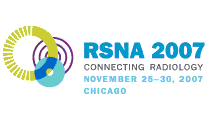
Abstract Archives of the RSNA, 2007
SSQ06-05
D-SPECT: A Novel Technology for High Speed Gated Myocardial Perfusion Imaging: A Comparison between High Speed D-SPECT and Dual Detector Anger Camera (A-SPECT)
Scientific Papers
Presented on November 29, 2007
Presented as part of SSQ06: Nuclear Medicine (Cardiovascular)
Tali Sharir MD, Presenter: Consultant, Spectrum Dynamics Ltd
Daniel S. Berman MD, Abstract Co-Author: Research grant, Bristol-Myers Squibb Company
Research grant, Astellas Group
Research grant, Tyco Healthcare (Mallinckrodt Inc)
Research grant, Siemens AG
Speaker, Bristol-Myers Squibb Company
Speaker, Tyco Healthcare (Mallinckrodt Inc)
Speaker, Astellas Group
Stockholder, Spectrum Dynamics Ltd
Konstantine Merzon, Abstract Co-Author: Nothing to Disclose
Vitali Prochorov, Abstract Co-Author: Nothing to Disclose
Dalia Dickman, Abstract Co-Author: Vice President, Spectrum Dynamics Ltd
Simona Ben-Haim MD, DSc, Abstract Co-Author: Consultant, Spectrum Dynamics Ltd
Shlomo Ben-Haim, Abstract Co-Author: Shareholder, Spectrum Dynamics Ltd
et al, Abstract Co-Author: Nothing to Disclose
et al, Abstract Co-Author: Nothing to Disclose
Gated myocardial SPECT imaging by Anger SPECT (A-SPECT) has prolonged imaging time. A novel, compact camera (D-SPECT, Spectrum-Dynamics), was designed to increase sensitivity as well as spatial and energy resolution. The study compares high speed D-SPECT to A-SPECT imaging for the evaluation of myocardial perfusion.
Thirty patients (27 men, 16 with known CAD) underwent one day Tc99m MIBI stress/rest SPECT. D-SPECT images were performed within 30 min after A-SPECT. Stress/rest acquisition times were 19 and 11 min respectively for A-SPECT, and 4 and 2 min respectively for D-SPECT. Images were visually analyzed using a 20-seg model to calculate summed stress (SSS) and rest (SRS) scores. Images were scored for quality, using a 1-5 scale (1=poor, 5=excellent), and assessed for confidence of interpretation. Post stress EF and LV volumes were compared in 11 patents. Myocardial counts per min (cpm) were calculated for both A-SPECT and D-SPECT.
Myocardial count rate was significantly higher in D-SPECT compared with A-SPECT (384k/min ± 134k/min vs 47k/min ± 14k/min, respectively, p<0.0001) for stress, and (962k/min ± 426k/min vs 136k/min ± 37k/min, respectively, p<0.001) for rest.
Image quality was rated good and higher in 29 (97%) cases for D-SPECT, and 18 (93%) cases for A-SPECT (p=NS). D-SPECT SSS and SRS correlated linearly with A-SPECT respective scores (r=0.84, p<0.0001 for SSS, and r=0.92, p<0.001 for SRS). Twenty three studies (77%) were diagnosed as definite normal or abnormal by D-SPECT, and 22 (73%) by A-SPECT (p=NS). Analysis of gated SPECT in 11 patients yielded that D-SPECT post-stress EF, EDV and ESV were highly correlated with A-SPECT measurements (R 0.87, 0.97, 0.99, respectively, p<0.001).
D-SPECT is a novel technology, providing high image quality in one fifth the imaging time with up to 8 times increased sensitivity.
The benefits related to the increased sensitivity include improved patient comfort due to rapid acquisition and potential lowering radiopharmaceutical dose. The superior image quality should translate to more accurate and fewer equivocal interpretations than are observed with A-SPECT.
Sharir, T,
Berman, D,
Merzon, K,
Prochorov, V,
Dickman, D,
Ben-Haim, S,
Ben-Haim, S,
et al, ,
et al, ,
D-SPECT: A Novel Technology for High Speed Gated Myocardial Perfusion Imaging: A Comparison between High Speed D-SPECT and Dual Detector Anger Camera (A-SPECT). Radiological Society of North America 2007 Scientific Assembly and Annual Meeting, November 25 - November 30, 2007 ,Chicago IL.
http://archive.rsna.org/2007/5013810.html

